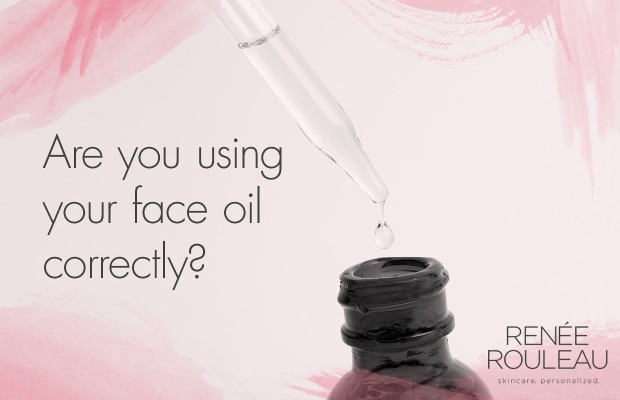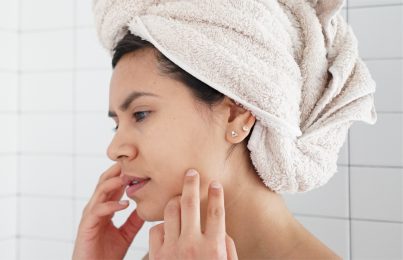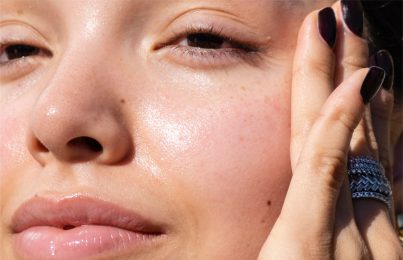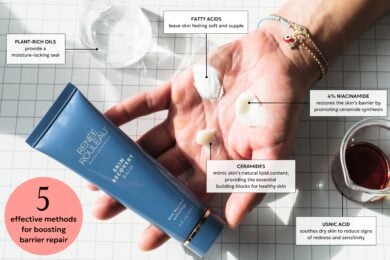Are you using your skin oil wrong?
The popularity of facial oils are at an all-time high and there is no quicker way to give the look of moist, glowing and radiant skin than with the application of an oil. With regular use, they can dramatically repair a damaged moisture barrier (the underlying cause of dryness and sensitivity) and bring the skin back to a healthier state. However, skin oils are tricky in that they have a certain place within a multi-step, at-home routine and many people are using them at the wrong time.
In this post, I’ll explain exactly how skin oils work and the right time to use them for maximum benefit and optimum skin health.
How are skin oils used?
You must first understand their molecular size
Skin oils as ingredients have always been used in creams and lotions, but now they can be found in a more concentrated form such as in a treatment product (a bottle with a pump or dropper), in a liquid cleansing oil, or in a cleansing balm. I’m a huge fan of skin oils used in treatment products but NOT when used in a cleansing balm or liquid cleansing oil such as in the double cleansing method. You can read my thoughts about this method here.
What you need to understand about all skin care products, whether it’s a cleanser, toner, serum, moisturizer, mask or oil, is that they have their own viscosity (weight) as well as a molecular size. This dictates how light or heavy it will feel when it’s applied to the skin, how many layers within the skin’s surface it will penetrate and for what type of skin (oily or dry) it’s best suited for.
Learn the correct order of when to use your face oil in your skincare regimen
When it comes to the order in which you should use a skin care product after cleansing, you always want to go from thinnest to thickest, which also should be from the smallest molecule to the largest molecule. The idea here is, anything with a small molecule, such as a water-based toner or serum, has the capability of passing the membranes to get into the skin the farthest. Large molecule products, such as a pure treatment oil, won’t do that as effectively but do serve the purpose of acting as a sealant. This allows it to give proper protection to defend the skin from external stressors and allow everything that was applied underneath (with a smaller molecular structure) to stay within the skin. (Ever noticed that after applying an oil, you can still feel it on the skin for many, many hours? Yep. This indicates that it’s staying on the surface and not absorbing much.)
How people are using their facial oils incorrectly is they are using them underneath a serum or moisturizer and you don’t want a tiny molecule on top of a giant one. Anything applied over an oil may not be offering as much benefit to the skin and could be wasting your money. (Read why you need to be using a serum.)
Where it gets confusing to consumers is that some companies market their oils as serums, so naturally, they will use them under a moisturizer. In this instance, you want to reverse it. After cleansing, toning and using a serum, always apply moisturizer and use the face oil on top.
To get the real benefit of an oil, use it correctly
The real benefit of a facial oil comes from its ability to act as a sealant, or as I like to refer to it, as a top coat, to help all the water-binding products underneath to work most efficiently. (All skin types need both oil and water.) The best and proper way in my professional opinion is to use a skin oil as the very last step in your routine so the largest molecule is on top. Anything with a smaller molecule will never be able to penetrate through a larger molecule.
As for HOW to apply facial oil, skin oils are best used for dry skin or any type of skin that’s in a climate with little to no humidity in the air. If you have a dry skin type such as skin types #7, #8 or #9, you can massage it into the skin over moisturizer. If you’re more of a combination to normal skin type like skin types #2, #5 and #6 that can benefit from a skin oil, especially in winter, you’ll want to pat (not massage) it onto the skin. The reason for the patting motion is that combination skin types still have their own oil built in and if you’re prone to clogged pores or occasional breakouts, a patting method allows it to really stay on the very top of the skin so only your lighter moisturizer is truly coming into direct contact with the pores. Just like a top coat.
Note: I can’t speak for every skin oil on the planet as every formula is made different with its own purpose, but in general, this is how most oils work. And make no mistake, I absolutely LOVE using a skin oil and recommend them all the time for my dry skin and frequent flyer clients who could use some amazing oil-based protection.
Other beneficial uses for skin oils
- When flying on an airplane, facial oils are amazing to use. Read how to save your skin from airplane dryness.
- Pregnant? Read how skin oils can help prevent stretch marks.
- Dry, itchy skin on the body? Read 8 tips to cure dry, itchy skin.
- Peeling from a peel? Read how to care for your skin after a chemical peel.
Celebrity Esthetician & Skincare Expert
As an esthetician trained in cosmetic chemistry, Renée Rouleau has spent 30 years researching skin, educating her audience, and building an award-winning line of products. Her hands-on experience as an esthetician and trusted skin care expert has created a real-world solution — products that are formulated for nine different types of skin so your face will get exactly what it needs to look and feel its best. Trusted by celebrities, editors, bloggers, and skincare obsessives around the globe, her vast real-world knowledge and constant research are why Marie Claire calls her “the most passionate skin practitioner we know.”



